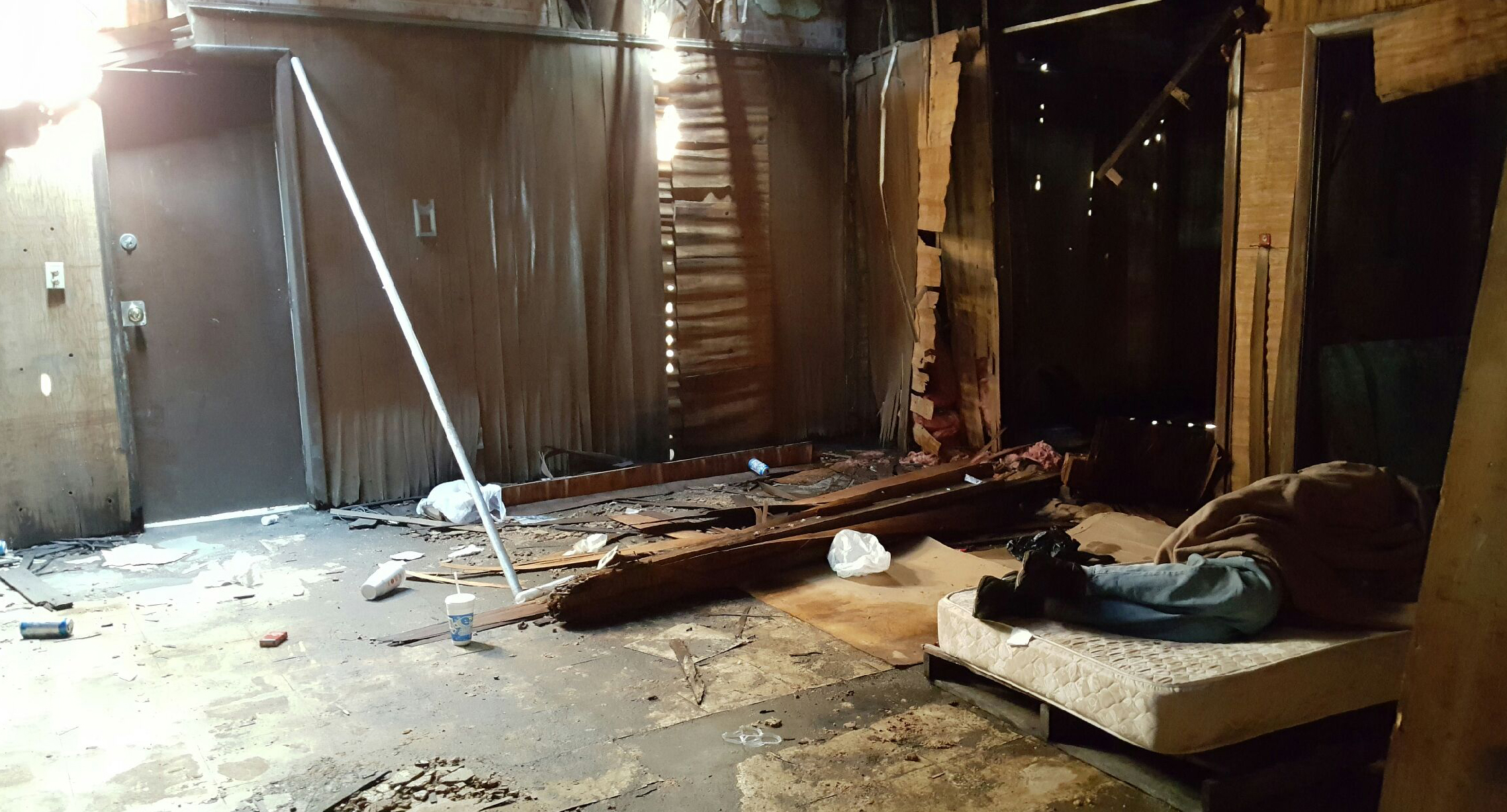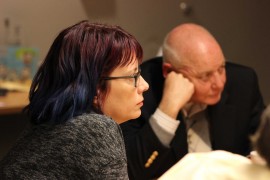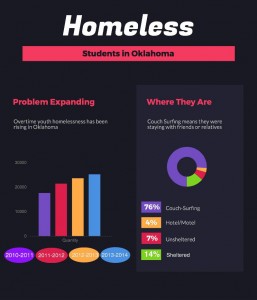Homeless in College: Five Students, Five Stories

Editor’s Note
Just after the beginning of the spring semester, the 12 students who enrolled in my Feature Writing class at Oklahoma City Community College were given an assignment: Write about the life of homeless college students in the Oklahoma City area.
They were forced to work as a team.
The project quickly went from an assignment for a grade to something that pushed each student way out of their comfort zone. My students met with advocates for the homeless. They traveled to shelters and schools for homeless students.
They bought homeless kids pizza.
And they had their hearts broken.
The result is this 3,000-word essay.
A story that examines the issue of the homeless college student in Oklahoma City. It includes data, video, photographs and some of the most compelling interviews I’ve read in a long, long time.
Respectfully,
M. Scott Carter
Professor of Journalism
–
One turned to crime.
A second quit college.
The third moves from place to place.
The fourth is trying to help.
And the fifth has built a better life.
Five different people with a unique story and a common thread; each has struggled to attend college while being homeless.
In Oklahoma, the homeless often go unnoticed. They live in the shadows. They stand on street corners, holding cardboard signs and asking for money. For the homeless, food and shelter are scarce and often nonexistent.
The plight of the homeless remains a huge issue. The problem is compounded when that homeless person is also a college student. The struggle often becomes so difficult that many students simply disappear completely.
Marcus’ story
Marcus Washington is 21. He grew up in the foster care system, but reunited with his biological mother and moved to Oklahoma. As a student at Oklahoma City Community College, Washington lived with his mother. The pair became homeless after they were evicted — they were seven months behind on rent.
At first, Washington turned to friends.
“I was sleeping out of my car and going from friend to friend’s house,” he said. “I was going up to the school and showering in the locker room. I was just doing everything I could to get by.”
However, after a while, being homeless took its toll. Faced with the mounting pressure of providing for himself and his family, Washington did the only thing he felt he could do — he turned to crime.
“I did some bad things,” he said. “I was selling drugs and doing everything I could to help make ends meet.”
Washington isn’t the only one. A report from the United States Interagency Council on Homelessness notes that some homeless people commit crimes due to lack of money and resources. Experts say many state prison populations include thousands of people who were homeless at the time of their arrest.
“Of the 11 million people detained or incarcerated in jails every year, as many as 15 percent report having been homeless,” the report said. “The sad truth is that for too many people, the experience of homelessness involves police encounters, lockups, courts, or jail and prison cells as much as it does shelter beds.”
In Oklahoma, estimates put the number of student-age homeless at more than 3,000. Those figures remain fluid, however. Because homeless advocates say no accurate number currently exists, an exact number is unknown. The Urban Institute’s Youth Count report said the number of homeless students vary from “tens of thousands to over a million.”
“Part of the difficulty is that different counts use different age ranges and definitions of homelessness,” the report noted. “Also, methods often used for counting homeless adults don’t accurately capture survival strategies common to youth, such as being mobile and transient, latching onto friends and staying in groups, or trying to hide in plain sight.”
Additionally, experts say many homeless youth don’t want to be found. “They may be fleeing abuse or fear being placed in foster care. Most aren’t connected to formal supports such as the child welfare, juvenile justice, and mental health systems, and many avoid or are unaware of available services,” the Urban Institute noted.
A study done by the Free Application for Federal Student Aid, FAFSA, indicated there are 58,000 college students who identified themselves as homeless or at risk of being homeless.
Forced into the gang life
Samuel Kadena,19, is a former student at Heritage College in Oklahoma City. He endured a struggle similar to Washington’s. Kadena comes from a low-income family who has suffered through periods of homelessness.
As a result, Kadena’s brother joined a local southeast Oklahoma City gang called “Eighteenth Street.” Once Kadena’s brother joined, Samuel had little choice but to follow in his brother’s footsteps.
“It’s easier to be a bad person than a good person,” he said. “My brother was working his way up, getting to know the O.G.’s of the clique. He wanted me to be like him.”
While Kadena was a teenager, his older brother and other members of the gang cornered him and beat him — the ritual used to bring in new members of the gang. Since his brother was a member of the gang, Kadena said he was expected to be a member as well.
“I had no other choice. They had a system. Once you turn thirteen, you get jumped in,” he said.
Crime and forced gang membership weren’t Kadena’s only problems. He found himself homeless after he told his family he was bisexual. Kadena said his mother kicked him out of their home because she didn’t approve of his sexuality. Disowned, he found refuge at the First Unitarian Church, which offers programs to help struggling LGBTQ youth.
After a while, the ice between Kadena and his mother thawed and she allowed him to return home, even though she continues to disapprove of his sexuality.
Today, Kadena’s brother remains in the gang. As for Samuel, he said he wants no part in that kind of lifestyle and has lost contact with his brother.
“Last time I heard, he got shot in the head, but he’s still alive,” he said.
Kim Woods, deputy director of the Homeless Alliance, a nonprofit organization that provides services for Oklahoma City’s homeless population, said many Oklahoma youths are forced out on the streets after “coming out” to their parents. Woods estimated that more than 40 percent of Oklahoma’s homeless young people became that way after they told their parents about their sexual nature.
“Jill” — a former college student who asked that her name not be used — came out to her parents at the age of 25, after attending the University of Central Oklahoma for five years. That event was difficult but Jill said it would have been worse had she told her parents while she was in college.
“If this situation would’ve happened five years ago (when she was in college), I don’t believe I would have been in school,” she said.
No answers from the foster care system
Savin is 21. Savin didn’t want to share his last name. He wasn’t able to finish high school. He lives in Oklahoma City but grew up in the Texas foster care system.
Abandoned by his foster parents after telling them he was transgender, Savin termed out of the Texas foster care system. Savin became homeless during the middle of his senior year after he turned eighteen. Savin didn’t complete high school.
Woods, the homeless advocate, said there is a negative image associated with the state’s foster care system and Oklahoma’s Department of Human Services. Many homeless youth, she said, would rather remain homeless than go to DHS.
“A large majority of homeless youth are hard to find because they don’t want to be found,” Woods said. “A lot of them are afraid of going to DHS.”
Former state Representative Joe Dorman, now the executive director of the Oklahoma Institute for Child Advocacy, wants to change that. “I want to believe most foster parents are in there for the right reasons, but it’s inevitable you’re going to have bad situations and bad actors in a situation,” he said.
The problems grow worse for those who age out of the foster care system. Many students have a difficult time adjusting to life on their own.
A study from Chapin Hall, a policy and research center at the University of Chicago, indicated that foster youth are more likely than their peers to be unemployed and homeless and, often, involved in criminal activity. According to the study, more than 75 percent of the young women who had been in foster care became pregnant after leaving the foster care system.
Chapin Hall researchers also found that, in a sample of about 600 young adults, nearly 60 percent of male students (ages 23 and 24) who aged out of child welfare systems in Iowa, Wisconsin, and Illinois had been convicted of a crime and more than 80 percent had been arrested.
Since aging out of the foster care system, Savin said he became a “drifter.” That is, he has never had a place he can truly call home.
Today, even after getting married, Savin continues to have a nomadic lifestyle.
“We just travel around. We stay somewhere close to a year, then we travel again,” he said. “We have a backpack and maybe like a tiny suitcase and that’s all we have, but that’s okay to us. We share everything. We had such abusive childhoods. We didn’t get to experience anything worth seeing, so we just kind of do our own thing now.”
The stories of Seth and Derek
Like Savin, Seth Satchell grew up in the foster care system and was homeless as a teenager, but unlike Savin, Satchell faced issues with substance abuse. He said drug use was the main reason he became homeless.
“I’ve gone through probably five or six bouts of homelessness that usually lasted for at least a few months a piece,” Satchell said. “I started using drugs when I was really young and it progressed all the way to the point where I moved out of my home at sixteen and dropped out of high school twice.”
Satchell describes himself as an “angry kid growing up.”
“I was adopted,” he said. “I didn’t know I was genetically predisposed to be an addict. Even though I was raised in a good Christian family, I just had this need to rebel. I left out of anger and stayed gone out of anger and I just continued to use and take my anger out on whoever and whatever I could.”
Satchell said he was too prideful and arrogant to seek help. He said his addiction frequently prevented him from having a stable living situation.
Eventually he decided to seek treatment. Satchell has been sober for nearly four years.
Derek Scarsella’s path to homelessness was different. Married, Scarsella decided to go to college. She wanted to be a role model for her daughter.
“I knew I could do better. I knew I was smart,” she said. “I was kind of in this place where being a stay-at-home mom was not fulfilling for me anymore. I wanted more. The whole reason I went back to school was for her.”
Starting college marked the beginning of Scarsella’s most difficult period. In addition to being a full-time student, she was still expected to maintain all of her usual responsibilities at home — without help from her husband.
“I did the cleaning, the cooking, his laundry, packed lunches, took care of the kids, did homework,” she said. “It created a lot of animosity between us. My husband was threatened by the idea of me going to school, pursuing an education–not being a stay-at-home mom anymore. It kind of snowballed from there.”
The problems escalated and, before long, Scarsella’s husband forced her out of their home.
As a result, she became homeless. She slept in her car for a while before she was able to find housing with a friend. She slept on an air mattress and did her best to take care of her child.
“About half of each week, I would have her,” she said. “She slept on the air mattress with me.” Her roommate, who was also her daughter’s nanny, watched the child during the day while Scarsella was at school.
Now divorced, Scarsella said her life is finally coming together.
“I’m now in a position where I have my own place, I’ve got my daughter. I’m doing well in school. I’m kind of normalizing a bit,” she said.
Scarsella still has joint custody of her daughter and currently works and goes to school full-time.
As an honor student, she has been able to pay for nearly all of her college expenses through scholarships. She said she plans to transfer to the University of Oklahoma next semester, and her goal is to earn bachelor’s and master’s degrees in political science before becoming a political science professor.
Scarsella said she hopes her dedication to school will show her daughter that she can someday pursue a higher education.
A problem that won’t go away
Because of continued budget cuts in Oklahoma, many state agencies have reduced services to the homeless population. Today, much of the burden for helping the homeless population is left to nonprofit organizations such as the Homeless Alliance and OICA.
Expressions is another organization that helps the homeless population. Kerri Bales, director of Expressions, said homelessness among young members of the LGBTQ community is prevalent. Bales said Expressions is dedicated to providing a safe place specifically for LGBTQ homeless youth.
“Pretty much every gay homeless kid I’ve met, them coming out to their parents was why they were kicked out, or at least played a major factor,” she said. “We try to be as low-barrier as possible. Most drop-in centers require an ID. All that we require is a name and an age, and you can put down whatever you like.”
Bales and the other volunteers try very hard to provide food every night for the kids, but meeting her clients’ nutritional needs can be very difficult. And though Expressions is not an overnight shelter, Bales said they try to stay open as late as possible so the kids can use computers with Internet access and ensure that they have whatever they need.
At OCCC, homeless students can get counseling and referrals to outside groups for assistance.
For officials like Dorman, that problem, particularly as it pertains to young adults and college students, won’t be fixed anytime soon.
“We have a severe need out there for college students,” he said. “That is something that needs to be brought more into light and more folks need to know about it.”
Dorman said colleges and universities must do more to address this issue and provide help for homeless college students.
“If you are essentially a customer attending the college, you should expect some benefit out of that, such as getting assistance to help you be a productive student and achieve your highest potential,” he said. Dorman said most colleges have little to no counseling for homeless students or programs that help with the transition to adult life.
Along with the state’s rapidly increasing homeless population, Dorman pointed to Oklahoma’s incarceration rate. He said the state imprisons the highest percentage of females in the civilized world. This creates a cycle that ensures that kids are seven times more likely to end up in jail themselves if they have a parent in jail.
“Oftentimes these kids are not in a situation where they have a choice in what happens to them. So you have to hope that the state will do the right thing.” he said.
As an example, Dorman said legislation filed by state Rep. Scott Biggs, R-Chickasha, would cause more problems than it solved. The bill would roll back changes made by voters last fall and restore felonies for drug use by individual within 1000 feet of a school.
Although the bill appears to keep kids safe, it harms the stability of many families, Dorman said.
And, because of ongoing budget cuts, Oklahoma’s Department of Human Services is less effective for homeless youths, Dorman said. He said the cycle of youths being taken from neglectful parents to foster parents and then back into the system is what keeps most of these children from transitioning as adults.
“That’s what’s painful to see, that these kids are bounced around like that,” Dorman said. “This is an issue that has been in the dark for a long time. I didn’t really know about the homeless problem with college students until I took this job and started visiting with folks about some of the issues.”
Hope in dark places
While the five students who shared their stories said their lives have improved, for each of them many obstacles remain.
Still, each survives.
And each continues to hope for a better future.
Seth Satchell currently works for Hope Community Services and has dedicated his life to helping veterans struggling with mental health issues, addiction and homelessness. He is also back in school and attending OCCC. “My goal is to do my two years here and then I’m gonna transfer to OU. I’m gonna work on getting my master’s (degree) in social work and then I’m wanting to start my own program,” Satchell said.
Derek Scarsella has excelled in school and will graduate in the spring. This fall, she plans to attend the University of Oklahoma.
Samuel Kadena said his life has improved. He wants to go back to college. However, right now he doesn’t have enough time or the necessary resources to enroll.
And Marcus Washington has now found a permanent living situation and is no longer involved in illegal activities. He acknowledged having done things he’s not proud of, but that time, he said, is past.
“I’m trying to change my ways and get back on my feet,” he said.